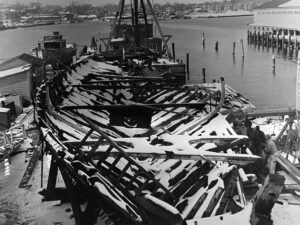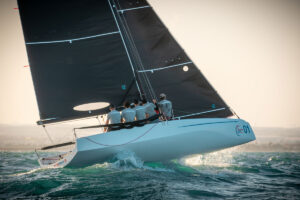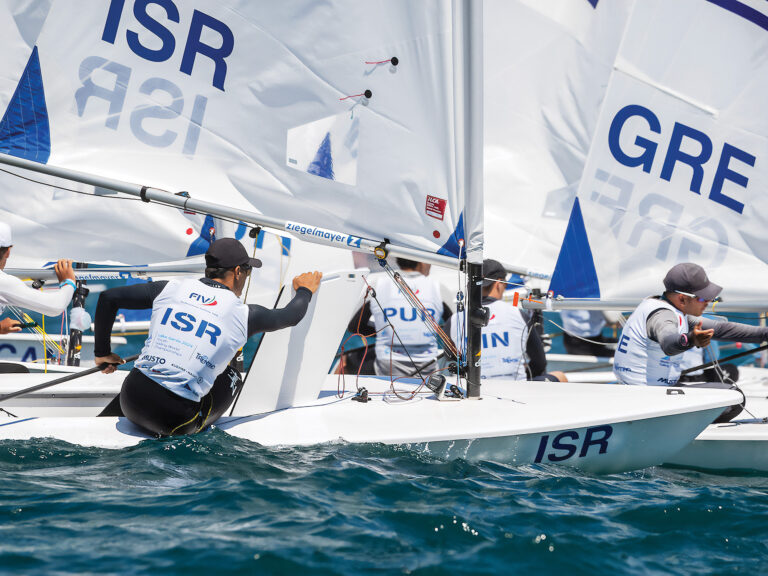The April sun and a warm southwesterly put a smile on Paul Neilsens face as we departed Falmouth, Mass., in his new Beneteau First 40.7 Tiberius. However, like any new owner, especially the new owner of a Cruising World Boat of the Year in the cruiser/racer category, Neilsen probably wouldve been smiling in a hailstorm.
Normally we might leave such a boat to Cruising Worlds readers, but the 40.7 has also gained an international reputation as an IMS winner. In fact, two of the three boats on Australias Kenwood Cup team are 40.7s so we decided to take a closer look. The 40.7, designed by Farr Yacht Design Ltd., comes with only one interior configuration. The three-cabin layout has plenty of light, wood, and generous 65 headroom, and the nav station has a large chart table, comfortable seat, and plenty of storage.
The cruising disguise notwithstanding, its evident from the sleek deck design that Bruce Farr and his associates aimed to create a fast racing boat. Beneteaus First Series race package for the boat includes a triple-spreader mast with hydraulic backstay and rod rigging, as well as a Tuff Luff headstay, standard spinnaker gear, Vectran halyards, folding prop, deep-draft 79 keel, and a Lewmar winch package. Its aluminum rig factors favorably under the dynamic allowance, a handicap adjustment the Offshore Racing Council introduced in 1996 to allow cruising-oriented designs to compete under IMS.
We hoisted the new 145-percent genoa and the large Dacron main as we exited the harbor and headed for Vineyard Sound. We tacked upwind while sailmaker Bill Fortenberry made some rig adjustments, allowing us to flatten the main and tighten the headstay. The boat felt powerful and steady, but in the building 15-knot breeze with its 892-sq. ft. of sail, the boat has more horsepower than the average cruiser might require. With the right combination of sail, rig adjustments, and rail meat you could top the 7.3 knots we attained in the freshening wind. The boat has a definite groove, which wasnt hard to find.
The 40.7 had little turbulence in its wake, and with a displacement over 15,000 pounds, the boat cut easily through the small chop. Upwind, with Beneteaus internal grid construction, the boat seems rigid enough to power through much rougher conditions. Sight lines from the helm are good. The large steering wheel is mounted on a pedestal designed to double as a footbrace if you choose to sit outboard, straddling the helm. The owner mounted the instrument displays on the pedestal, but they were hard to read if you stood to steer. It would be easy to mount displays on the mast so theyd be visible to all.
The removable seats in the cockpit is a nice feature–these provide comfortable bench seating and stowage while cruising but allow stand-up access to winches and more elbowroom when removed for racing. When the seats are removed, cockpit sole footpads for the main trimmer to brace against are exposed.
The European-style split mainsheet system runs from the elevated Lewmar traveler, situated in front of the steering pedestal, along the boom to the gooseneck, and then back along the deck to secondary winches. These were mounted on the cockpit coaming in front of the traveler, and like the traveler controls, theyre in easy reach.
We turned for home, doused the genoa, and reattached the roller furler used for cruising. While we were rigging this, we reached at almost seven knots under main alone, and when we finally set the 105-percent roller jib, the speed picked up to over 8 knots in 18 knots true. We cant vouch that the new instruments were calibrated correctly, but our GPS confirmed they were close.
Finally, we raised the spinnaker, and our speed increased to 10 knots with the wind on the quarter. We didnt expect the boat to plane at this speed or angle downwind, but, again, there is plenty of horsepower.
The term cruiser/racer usually means the boat has traded speed for comfort. In the racing configuration, however, we found the boat more powerful than some cruisers might want but on target for a race-oriented sailor. With over 235 boats already built worldwide and more on order, the market seems to have found plenty to like.
The price seems as comfortable as the interior. We estimate that the sail-away, race-ready price, including basic electronics, to be $200,000. The simple rig with no runners gives the boat a favorable handicap in IMS racing. The interior will please the entire family, and its 54-second/mile PHRF rating could make it a great boat for you sea-wolves looking to disguise your intentions of dining on the club racing circuit.









